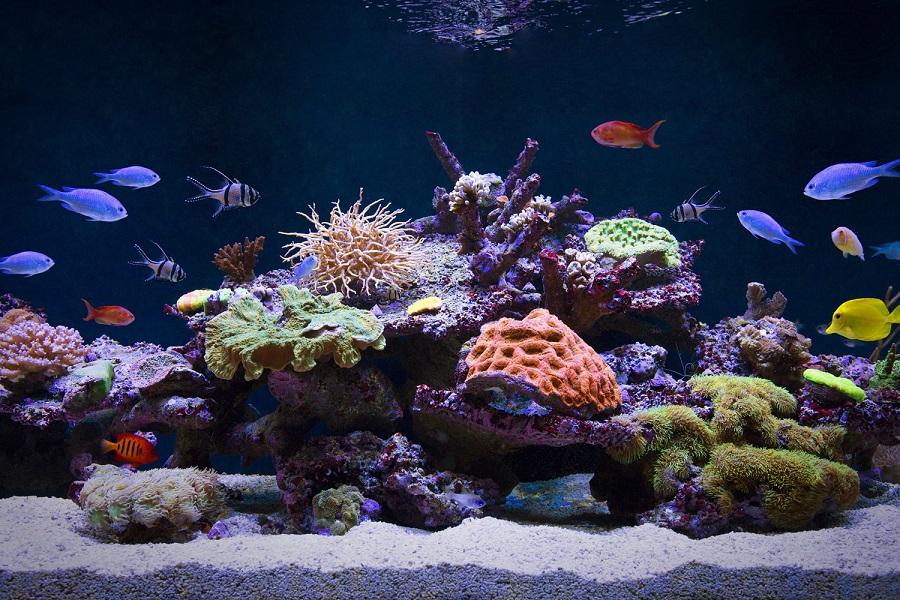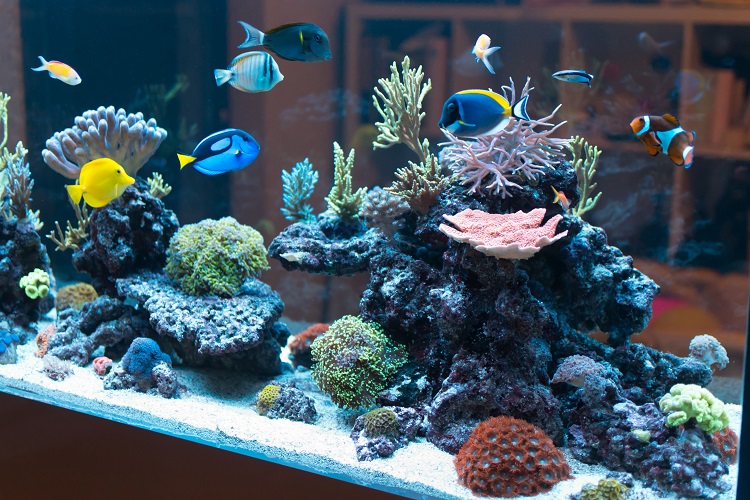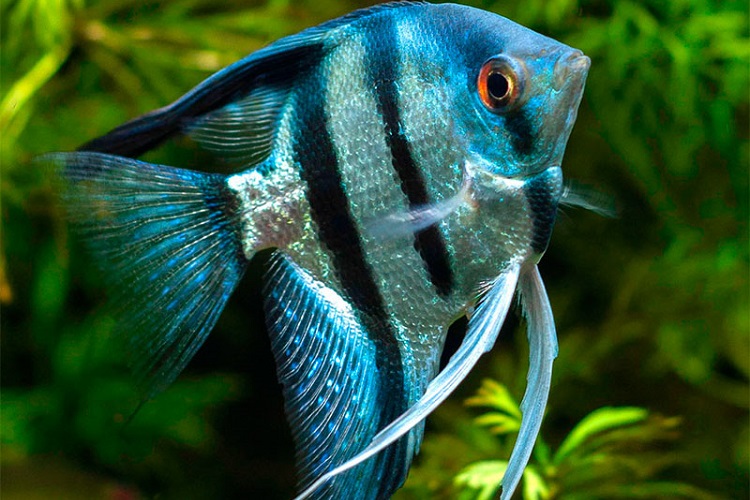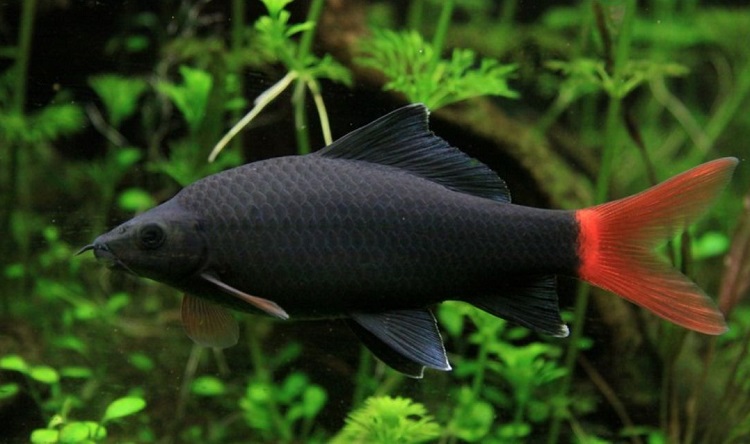Prior to placing different species of fish together in the same tank, you need to first find out if they compatible and can live together.
The reality is that not all species of fish can live with each other.
And there’s a danger of them fighting with each other and even fighting each other when they are incompatible.
You also need to make sure that there is enough space for all of them and that they’ll all be getting the same type of nourishment and can be kept in the same water temperature.
If they don’t have enough swimming space to move around, they may harm each other. By doing your research and getting to know which peaceful fish are compatible with each other, you have the best chance of choosing the right types of fish for your home aquarium.
So let’s take a closer look at peaceful fish compatibility.
Contents
What is fish compatibility?
“Fish compatibility” is described by aquarium hobbyists as the ability of different species of fish to peacefully coexist with other species.
While some active fish have a mild temperament and can be kept in a community tank with virtually any other species, some species tend to be aggressive and need to be kept alone.
So the key to maintaining a healthy community tank is stocking your aquarium with the right combination of species to ensure a healthy and happy community environment for all fish inside your home aquarium. However, in order to do this, you need to understand how to evaluate fish compatibility.
It’s also crucial to acknowledge that while the temperament of individual fish will vary to some degree, most species can be divided into various categories based on their compatibility with other fish.
Some hardy fish can get along with other fish under the right circumstances when others simply shouldn’t be kept without another species of tropical fish under any circumstances.
So unless you know the category in which the territorial fish you are considering keeping falls into, you should not move forward with stocking your tank. So let’s discuss predatory fish compatibility in greater depth.
What fish go well together?
When it comes to freshwater tank fish, generally species are divided into categories based on their temperament. However, the largest category of fish that are usually described as being peaceful and able to coexist with other species are known as “community species”.
This is because they have mild temperaments and can be kept with lots of other species of community fish.
Some of the species belonging to this group include Swordtails, Platies, Danios, Mollies, Guppies, and most larger Tetras. The fish belonging to this category are generally smaller in size and prefer being kept in schools with several of their own species.
The key, however, is that with this species that they are kept in groups of at least 4 to 6 of their own species. Some species such as serape tetras and tiger barbs are peaceful in larger groups but can become aggressive if kept singly or in pairs.
Some other fish belonging to the community species include:
- Catfish
- Corys
- Gouramis
- Loaches
- Plecos
- Rasboras
Non-aggressive freshwater fish
Simply because a fish looks pretty doesn’t necessarily make it nice. So you’ve got to be careful about the species you add into one tank as not all can coexist.
There is a handful of non-aggressive freshwater fish that can live peacefully with one another and additionally bring a new lease of life and color to the tank.
However, it can get very tricky, deciding which freshwater fish to keep while making sure your aquarium is as colorful as possible. The latter being of more importance as aggressive fish can turn the seemingly peaceful tank into a war zone in no time at all.
Aggressive fish tend to fight for weaker species of fish and can end up killing most of the populace of the fish tank. So it’s best to do your research beforehand instead of just mixing two species of stunning fish together and expecting them to just get along.
You can have a beautiful assortment of peaceful and non-aggressive cool freshwater fish for your aquarium if you know what you are doing.
Here are a few options for non-aggressive fish for your aquarium:
Angelfish
Angelfish are triangular in shape and usually silver in color, with black stripes. However, some other color variations include gold, yellow, plain silver as well as brown colored Angelfish.
Some of the most beautiful Angelfish include the Koi, Marble, Gold, and Sunset Blushing Veil Angelfish. An interesting fact about the species is that they can actually recognize their owners and are known for being intelligent.
While the cost of these fish can vary based on color variations, the Albino ones tend to be the most expensive.
Corydoras Catfish
These catfish are really pretty freshwater aquarium fish and look a lot like catfish. They tend to live in schools of 5 to 10 and are highly compatible with other species of fish.
Some of the facts about them are that they are always hungry and can be found scavenging the base of the tank all day long. Some varieties of this type of fish include:
- Corydoras sterbai
- Panda Corydoras
- neon tetra orange Corydoras
- Pink Corydoras
Barbs
We’ve included Barbs in this category, but, they are semi-aggressive in nature when left alone. However, they must always be kept in groups of 6 to 8 of the same species.
They come in a wide variety of colors, are very small, and look very pretty inside your tank. Some of the popular sub-species include:
- Cherry Barbs
- Rosy
- Tiger
- Green tiger
- Denison,
- Gold
- Snakeskin Barb
The most expensive of these species is Dennison Barb and that rest of the species all cost the same which is anywhere between 2 to 7 dollars.
Danios
Danios are considered peacemakers of the tank and will always try to break up a fight between two Betta females or males.
Even though Bettas are strikingly beautiful, they are also fighters and not good for social groups. The best Danios:
- Long Finned Zebra
- Zebra Danio
- Leopard Danio
- Gold Danio
Goldfish
The Goldfish has dozens of varieties literally.
There are so many to choose from and as you all know, Goldfish are not always golden and are often lazy, curious, and peaceful. Some of the most popular varieties include:
- Bubble Eye
- Comet
- Celestial Eye
- Black Moor
- Fantail Panda Moor
- Oranda
- Pearl Scale
- Lionhead
- Pompom
- Ranchu
- Shubunkin
- Telescope Eye
- Ryukin
- Veil Tail
The bonus is that these beautiful fish are not expensive at all.
Guppies
Guppies are exquisitely tiny, beautiful, and also friendly.
Additionally, there are no limits to the shapes and bright colors available with the species of fish. So you can choose whichever yields to your personal preference. Some of the most popular and stunning varieties include:
- Albino Guppy
- Tux Guppy
- Coral Guppy
- Deltas Guppy
- Blue Cobra Guppy
- Flame Guppy
- Mosaic Guppy
- Moscow Guppy
- Glass Guppy
- Red Fire Guppy
The species is also affordable, and you should always purchase them in a bunch of between 6 to 8.
Although they look quite small, they are full of energy and live for quite a while.
Koi
Koi are considered ornamental fish because of their gorgeous splash of color and large size. They do also have an exceptional lifespan and can live for more than 100 years.
Therefore they are considered spiritual beings in some cultures. These beautiful fish are also serene, docile, and at ease with their surroundings. A few Species are:
- Asagi
- Tancho
- Doitsu
- GinRin Kohaku
- Bekko
- Kumonryu
For such large and beautiful fish, they are relatively inexpensive unless of course it’s of pure lineage and in that case, they can cost in excess of thousands of dollars.
But we’ve heard that the ones sold at Walmart are not pure and can cost five dollars each.
What fish should you avoid?
Red Tail Shark
The Red Tail Shark is one of the most exciting fish species to have in your tank.
Not only are they highly active and naturally curious, but they spend most of their time darting back and forth at the bottom of the tank. They also enjoy investigating every nook and cranny of the aquarium.
However, this exciting and fun fish needs ample space and a well-decorated tank to create a community and to truly thrive.
And if they don’t get this, their aggressive tendencies will come to the forefront. Visually they are quite simple; however, that simplicity also makes them beautiful in their own way.
The entire body is covered with dark black scales, and the only exception is the tail fin which is a vibrant red color.
Red Tail Sharks stem from freshwater lakes and streams in Thailand. They’re considered to be critically endangered so if you can still find them in the aquarium trade, consider yourself lucky.
These fish are hardy and adapt relatively well to life in captivity. With the right amount of care, they can provide you with many years of enjoyment.
Flowerhorn Cichlid
The Flower Cichlidspecies hails from Southeast Asia but has spread throughout the globe since its discovery. In countries such as Asia, wild populations were caused by pets being released into the wild.
These eel-like fish are easy to identify due to their unusual shape and vibrant color. The most noticeable feature being the nuchal hump which is large on male specimens. The prominent limbs, bulging eyes, and lumpy chin all round off the physical features.
As for color, they are predominantly bright pink. The front part of the body is covered in Fuscia pink, and the color tends to fade off into a more muted tone as it reaches the tail. For some unique detail, there are several large black spots along the body.
Like many other Cichlid species, they are very aggressive in nature. There are also playful and known to respond to human interaction and put on a show.
Afer Knife
Afer Knife fish are widely distributed all over Central and West Africa. The natural habitat of this fish is densely planted rivers. However, they do tend to stick to that of the river bed and search for prey.
So in captivity, they naturally prefer similar living conditions. These fish do best when they live in dimly lit up tanks that are decorated with driftwood and lots of plants. The water movement should be kept to a minimum to give the fish several places to hide.
What you should know about these fish is that they are extremely predatory. They don’t do well with others at all. Even when it comes to fish of the same species. So they should be kept alone to prevent territorial disputes.
It’s fun to watch when you’re feeding these fish because they are predatory and enjoy eating live flake foods.
So the diet should consist of Lance fish or other live feeder fish species, including shrimp, bloodworms, and earthworms. In the event that this is not available, they will accept carnivorous pellets or frozen snacks and protein.
Dwarf Pea Puffer
These fish look cute and unassuming; however, don’t get that fool you. They’re quite aggressive and have no problem fighting with other fish.
This is why they do well with fish of the same species. And you also need to ensure that there is room enough for every fish to have some time alone. Or else you may run into some territorial disputes.
A must-have for these fish is a well-decorated tank. Since they hail from lakes and rivers in Southwest India, where the waters are teeming with life, you’ll need to replicate the natural surroundings. This will keep the fish happy and healthy and, more importantly, occupied.
They also enjoy lots of vegetation and plants, which make for active hiding spots for the fish whenever they are feeding threatened.
The same goes for driftwood and rock formation. These fish are curious creatures, so don’t be surprised if you see them investigating every inch of the aquarium.
Black Wolf Fish
The Black Wolf fish is naturally found throughout the Amazon River basin. They are also natural-born predators. In fact, they prefer to lurk at the bottom of the water bed to can keep a watchful eye on the potential prey that’s unfortunate enough to swim by.
One of the advantages that this fish has is that its appearance allows it to blend into natural environment. It’s covered in brown and features a thick stripe of black. These fish make an excellent showpiece when kept in captivity.
However, it’s best left alone and kept alone. They can, however, live with other fast-moving aggressive fish of a similar size. The Black Wolf fish prefer warm water between 76 and 82°F. They also prefer neutral pH levels; however, they can tolerate some fluctuations without any issues.
As for food, live prey works best. They enjoy snacking on insects and live fish. But, they can be weaned onto frozen foods, but these foods need to be packed full of protein to keep the fish healthy.
Can fish learn to live together or is there always a danger?
It is highly unlikely that aggressive fish can learn to live together because they are predators by nature.
This means they need to dominate the environment, and if they cannot do that, they will perceive other fish around them as a threat and attack.
5 Best Fish For A Beginners Aquarium That Gets Along
If you’re a first-time aquarium owner, then the following is a list of hardy, budget-friendly and colorful fish to keep:
- Rasboras
- Goldfish
- Tetras
- Corydoras
- Platies
- Bettas
- Kuhli Loaches
- Angelfish
- Danios
- Guppies
Conclusion
Knowing which fish to keep together and which to avoid will help to create a harmonious, happy, and healthy aquatic environment for your finned friends.

Ian Sterling, founder of Fishlab.com, began his aquarium journey over 30 years ago, driven by a deep fascination for fish and their diverse personalities. His website, Fishlab.com, is dedicated to making fishkeeping accessible and enjoyable, offering beginner-friendly guidance, expert insights, and a community for aquarists to connect and share experiences.






